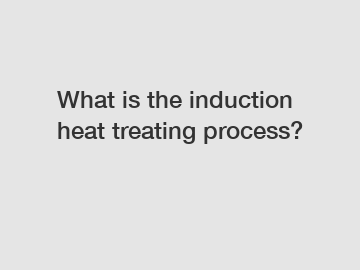What is the induction heat treating process?
What is the induction heat treating process?
The induction heat treating process is an essential technique used in various industries to enhance the mechanical properties of metals. It involves the use of high-frequency induction heating to achieve controlled heating and cooling cycles within a material. This process can significantly improve the strength, hardness, and durability of metal components, making them suitable for a wide range of applications. Let's delve into the intricacies of the induction heat treating process and explore its applications, advantages, and limitations.
1. Understanding the induction heat treating process:

The induction heat treating process utilizes electromagnetic induction to generate heat within a material. An induction coil creates a high-frequency alternating magnetic field, which induces electrical currents known as eddy currents within the metal. These currents generate heat due to the material's resistance, leading to efficient and localized heating. Once the desired temperature is reached, the metal is rapidly quenched to obtain the desired mechanical properties.
2. Applications of induction heat treating:
Induction heat treating finds widespread use in various industries, such as automotive, aerospace, manufacturing, and oil and gas. It is commonly employed to harden steel components, including gears, shafts, bearings, and tools. By selectively heating specific regions, the process ensures surface hardening without affecting the core properties. Moreover, it can be used for case hardening, tempering, annealing, and stress relieving, offering versatility in treatment options.
3. Advantages of induction heat treating:
The induction heat treating process offers several advantages over traditional heating methods. Firstly, its localized heating capability significantly reduces energy consumption and cycle time. This efficiency translates into cost savings and increased productivity. Additionally, induction heating allows for precise control of the heating depth, allowing manufacturers to achieve specific hardness profiles. The ability to automate induction heat treating processes further enhances production efficiency and consistency.
4. Limitations of induction heat treating:
Despite its advantages, induction heat treating has a few limitations. One challenge is the need for specialized equipment, including power supplies, induction coils, and cooling systems. The initial investment for such equipment can be substantial, particularly for small-scale operations. Additionally, the process is primarily applicable to ferromagnetic materials, limiting its use on non-magnetic alloys. It is crucial to consider material selection and design compatibility to optimize the benefits of induction heat treating.
5. Ensuring process control and quality:
Process control is of utmost importance in induction heat treating. Precise control of the power input, heating duration, and quenching process is required to achieve the desired results consistently. Employing advanced temperature monitoring and feedback systems can help maintain tight tolerances throughout the treatment. Regular inspection and quality control tests, such as hardness and microstructure analysis, ensure that the components meet the required specifications.
6. Embracing induction heat treating for the future:
As industries continue to push the limits of performance and efficiency, induction heat treating holds immense potential. Researchers are constantly developing new alloys and refining the process parameters to achieve superior results. Furthermore, advancements in simulation and modeling techniques enable better prediction and optimization of heat treating outcomes. The incorporation of robotics and automation into induction heat treating systems will only enhance their reliability and productivity.
In conclusion, the induction heat treating process is a vital technique for improving the mechanical properties of metals. With its ability to selectively heat and harden metal components, it finds extensive applications across diverse industries. While offering advantages such as energy efficiency, precise control, and automation possibilities, it is crucial to acknowledge its limitations and the requirements for specialized equipment. By embracing advancements and ensuring process control and quality, the induction heat treating process will continue to play a pivotal role in shaping the future of manufacturing and engineering.
Are you interested in learning more about OEM induction heat treating scanner manufacturer, OEM Bar Induction Tempering Machine factory, chain annealing furnace transmission chain? Contact us today to secure an expert consultation!
138
0
0


Comments
All Comments (0)